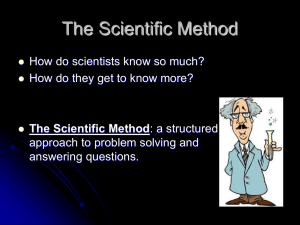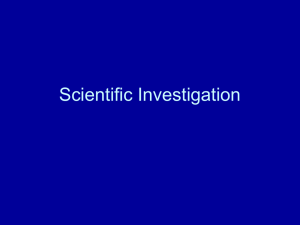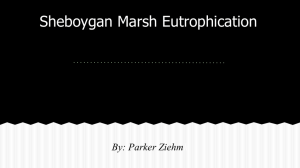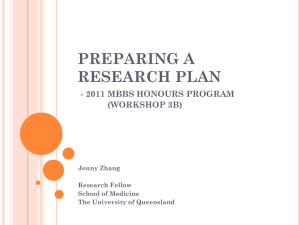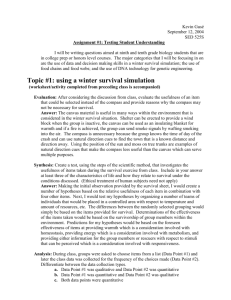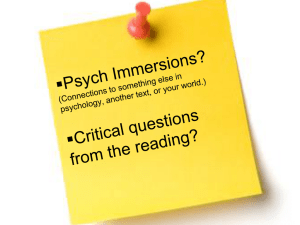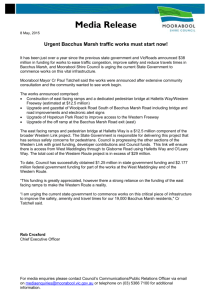1.1_What_is_Science
advertisement
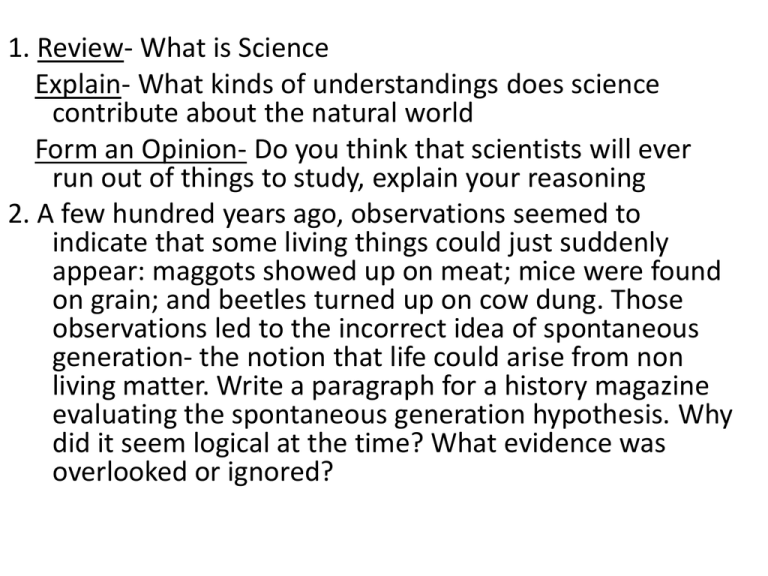
1. Review- What is Science Explain- What kinds of understandings does science contribute about the natural world Form an Opinion- Do you think that scientists will ever run out of things to study, explain your reasoning 2. A few hundred years ago, observations seemed to indicate that some living things could just suddenly appear: maggots showed up on meat; mice were found on grain; and beetles turned up on cow dung. Those observations led to the incorrect idea of spontaneous generation- the notion that life could arise from non living matter. Write a paragraph for a history magazine evaluating the spontaneous generation hypothesis. Why did it seem logical at the time? What evidence was overlooked or ignored? THE SCIENCE OF BIOLOGY 1.1 What Is Science? Where did plants and animals come from How did I come to be Humans have tried to answer these questions in different ways. Some ways of explaining the world have stayed the same over time. Science, however, is always changing. What Science Is and Is Not What are the goals of science? To provide natural explanations for events in the natural world To use those explanations to understand patterns in nature and to make useful predictions about natural events. What Science Is and Is Not Biology is not just a collection of never-changing facts or unchanging beliefs about the world Some scientific “facts” will change soon—if they haven’t changed already – and scientific ideas are open to testing, discussion, and revision. Science as a Way of Knowing Science An organized way of gathering and analyzing evidence about the natural world Researchers can use science to answer questions about how whales communicate, how far they travel, and how they are affected by environmental changes. Science as a Way of Knowing Science deals only with the natural world Scientists collect and organize information in an orderly way, looking for patterns and connections among events Scientists propose explanations that are based on evidence, not belief. Then they test those explanations with more evidence. The Goals of Science To provide natural explanations for events in the natural world To use those explanations to understand patterns in nature and to make useful predictions about natural events. Science, Change, and Uncertainty Almost every major scientific discovery raises more questions than it answers Science rarely “proves” anything Allows us to build enough understanding to make useful predictions about the natural world. Scientific Methodology Observing and asking questions Making inferences and forming hypotheses Conducting controlled experiments Collecting and analyzing data Drawing conclusions. Observing and Asking Questions Observation The act of noticing and describing events or processes in a careful, orderly way. Observing and Asking Questions Example Researchers observed that marsh grass grows taller in some places than others. This observation led to a question: Why do marsh grasses grow to different heights in different places? Making Inferences and Forming Hypotheses Inferences Logical known. interpretations based on what is already Making Inferences and Forming Hypotheses Hypothesis Statement that explains an Observation Tested with experiments Can be proved false Can NOT be proved true. Making Inferences and Forming Hypotheses Hypothesis MUST contain What you are measuring What you are changing What you think will happen. Making Inferences and Forming Hypotheses Researchers inferred that something limits grass growth in some places. They hypothesized that marsh grass growth is limited by available nitrogen. Designing Controlled Experiments Testing a scientific hypothesis often involves designing an experiment that keeps track of various factors that can change, or variables Examples of variables include temperature, light, time, and availability of nutrients. Controlled Experiment An experiment when only ONE variable is changed and the rest are all kept constant or unchanged. Variable Things that are or could be different in the experiment Want to have them all the same except one Why? Controlling Variables It is important to control variables because if several variables are changed in the experiment, researchers can’t easily tell which variable is responsible for any results they observe. Dependent Variable What is measured, What occurs, Y axis Independent Variable What you are changing or testing, X axis. Control and Experimental Groups Control The base, thing you haven’t changed, what it normally is Used so you can compare your result with what normally should occur Experimental Groups The same as the control group except for the one independent variable. Designing Controlled Experiments Researchers selected similar plots of marsh grass. All plots had similar plant density, soil type, input of freshwater, and height above average tide level. Designing Controlled Experiments Researchers added nitrogen fertilizer (the independent variable) to the experimental plots. They then observed the growth of marsh grass (the dependent variable) in both experimental and control plots. Collecting and Analyzing Data Scientists record experimental observations, gathering information called data Two main types of data Quantitative data Qualitative data. Collecting and Analyzing Data Quantitative Data Numbers obtained by counting or measuring. In the marsh grass experiment- i.e. Number of plants per plot, plant sizes, and growth rates- Preferred data type Qualitative Data Descriptive and involve characteristics that cannot usually be counted- Notes about foreign objects in the plots, or whether the grass was growing upright or sideways. Sources of Error Data collection Tools used to measure the size and weight of marsh grasses, for example, have limited accuracy Data analysis The larger the sample size the more reliable the data. Collecting and Analyzing Data Drawing Conclusions Scientists use experimental data as evidence to support, refute, or revise the hypothesis being tested, and to draw a valid conclusion Marsh grasses grew taller than controls by adding nitrogen. Drawing Conclusions Experiments Are Not Always Possible Observations are then used Examples How animals interact in the wild Ethical issues especially with people.

